India and Pakistan have always managed to polarise emotions throughout history. Be it during the horrors of partition, unfortunate wars or even in the race to become a nuclear power, the rivalry has been intense.Over the years, much of that intensity has been replicated on the cricket field. The sport has been bringing together and dividing - both at the same time - millions of people on either side of the border. Now, once again, the two teams are primed for a face-off - in the 2016 ICC World T20 - and everyone is waiting for the contest with bated breath.The subcontinent’s rich cricketing history has always been characterized by the numerous great players that the two nations have produced. And the matches involving these legends have ensured that the India-Pakistan cricket rivalry remains eternal - the battles don't fade away, much like the Axe Signature line of body perfumes.Here, we take a look at six unforgettable clashes between India and Pakistan over the years:
#6 Asia Cup T20 2016 at Mirpur
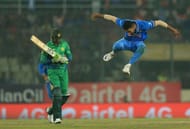
It’s hard to imagine a T20 contest that lasted for just 33 overs and saw merely 170-odd runs being scored across both innings making it to the list of the most unforgettable India-Pakistan clashes.
But it boiled down to the individual brilliance of two of the finest performers produced by either side that dictated how deeply the game would be engrained in the minds of those who follow this rivalry.
The Indian bowlers, aided by Pakistan’s tendency to self-destruct, ran amok, dismissing the opposition for a paltry 83 runs on a surface that was doing quite a bit. The top scorer for Pakistan was Sarfaraz Ahmed with 25 runs.
However, it was the electrifying second innings and one of the greatest fast-bowling spells one will ever see that changed the tenor of a contest that seemed all too one-sided at half time.
Mohammad Amir, on comeback trail, created magic with the ball in hand, dismissing the Indian top-order in no time. It then came down to Virat Kohli and his ability to save India after the Men in Blue found themselves at a spot of bother three down for just eight runs.
The Amir versus Kohli duel that lasted for a couple of overs saw the world’s best batsman on current form being tantalized and tested by an incredible bowler who was away from international cricket for five years. It was this face-off that made the encounter truly memorable - there was very little for Pakistan to defend, and yet, India were made to fight hard for each and every run.
By the time India managed to reach the finish line, they had a little more than four overs remaining, with five wickets in hand. What seemed to be a walk in the park initially, turned out to be trial by fire for all Indian batsmen apart from Kohli.
This game is unforgettable not just because of the intensity of the contest or how closely fought it was. It is unforgettable because it produced perhaps the most mesmerizing bat-and-ball duel that one will see in a long time to come.
#5 1st ODI, Samsung Cup 2004 at Karachi
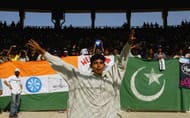
The brief for India was to not only win games, but also win hearts. It was the Men in Blue’s first bilateral series in Pakistan after 15 years, and it couldn’t have got off to a better start.
In one of the most anticipated battles of the mid-2000s, an exceptionally strong Indian squad went up against a formidable Pakistani line-up who matched them strength for strength.
On a good batting deck at Karachi, India were put in to bat and were led in their efforts by their three modern-day stalwarts. Virender Sehwag provided the initial burst with a 57-ball 79, and was followed by Sourav Ganguly who danced his way to a run-a-ball 45 with the help of three fours and two sixes.
But it was Rahul Dravid’s two-hour batting effort (dismissed for 99) that changed the course of the game and allowed India to not only cross the 300-mark but also go sufficiently ahead and post a daunting target of 350 runs for the opposition.
Despite two early strikes, Pakistan seemed well on course to meet the huge target, much due to the batsmanship shown by two of the country’s finest – Inzamam ul-Haq and Yousuf Youhana. Inzamam put on a 135-run partnership with Youhana, and a 109-run partnership with Younis Khan, before falling to the left-arm spin of Murali Kartik for a 102-ball 122.
All-rounder Abdul Razzaq nearly stole the game away before some incisive bowling and an exceptional effort in the field by Mohammed Kaif brought the equation down to 9 runs from 6 balls, with three wickets in hand.
Ashish Nehra then bowled out a tight final over, giving away just three runs and capping that achievement with Moin Khan’s wicket off the final delivery.
India took the game by 5 runs and later went on to win the series 3-2, marking the end to one of the most thrilling India-Pakistan one-day series in ages.
#4 3rd Final, Independence Cup 1998 at Dhaka
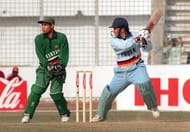
Bangladesh was hosting a tri-series to celebrate 25 years of its independence, but it was India and Pakistan who produced all the fireworks in the tournament.
After the longtime rivals set up a best-of-three match final, Sachin Tendulkar produced a masterclass in the first final to give India the initiative. But Pakistan struck back through their bowlers in the second final, setting the stage for an electrifying decider.
Saeed Anwar and Ijaz Ahmed played some electrifying cricket alright, sweeping the bowlers with abandon to take Pakistan to a mammoth score of 314 in the light-shortened quota of 48 overs. No team had ever successfully chased a total as big as that in ODIs at that point; the previous record chase was 313, scored by Sri Lanka in reply to Zimbabwe's 312 back in 1992.
But India's openers didn't let the size of the task dampen their spirits. Tendulkar smashed a 26-ball 41 to get his side off to a flier. While he was dismissed before he could get to his 50, his exit failed to bring too much relief for Pakistan as Robin Singh continued carting the ball to all parts of the ground.
But the man who truly took the game away from Pakistan was Sourav Ganguly, who stroked his way to a delicious 124 off 138 balls. Ganguly was the backbone of the innings, and expertly guided the chase right up to the 43rd over with some beautiful cuts and drives.
Ganguly's wicket did bring a bit of panic to the Indian dressing room though; when the seventh wicket fell in the 47th over, it was anybody's game. But Hrishikesh Kanitkar was still at the crease, and nobody could have predicted the immortality he was about to achieve.
The match went down to the last over, and India needed three runs off the last two balls, to be bowled by their frequent tormenter Saqlain Mushtaq. But Kanitkar threw all the pressure out of the window as he swiped the penultimate ball for a famous four, and the entire country erupted in joy.
After an epic nail-biting encounter India had broken the record for the highest ever ODI chase, and Ganguly and Kanitkar had forever etched their names in the annals of cricketing folklore.
#3 Semi-Final, ICC Cricket World Cup 2011 at Mohali
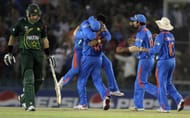
Yet another World Cup game, yet another loss for Pakistan.
Barely a few hundred kilometres from the Wagah Border, the action unravelled in Mohali with an unparalleled level of political attention. The dignitaries in attendance included the Prime Ministers and Presidents of both the countries, alongside the Head of the ruling party in India and a host of other celebrities.
The interest that the game garnered almost took all the attention away from the subsequent match, the final to be played in Mumbai.
India entered the competition as a well-oiled unit, having lost just one game in the group stages, while Pakistan too had managed to peak at the right time. It was a competition between two sides at the height of their prowess.
Sachin Tendulkar and Virender Sehwag, chief architects of India’s 2003 win against the arch rivals, took on the Pakistani bowlers with gusto. Sehwag fell just before India could cross the 50-run barrier, yet again, in the sixth over itself.
Tendulkar though batted on, courtesy a slew of chances that came his way in the form of Pakistan’s poor fielding. After being reprieved on multiple occasions, Tendulkar fell to Saeed Ajmal, 15 runs short of his 100th international hundred.
It was Suresh Raina who provided the team with a lower-order boost, helping India score exactly 260 runs.
Pakistan’s chase was always going to be tricky, considering that the ball did more under lights and that it was a pressure game. But at 103/2 after 23 overs, Pakistan were on course to making the target appear all too easy, before they decided to press the suicide button.
From 103/2, a mini collapse resulted in the team becoming 150/6. By the time the 9th wicket fell for 208 runs, 46 overs had passed and for the second time in four years, Pakistan were dependent on Misbah ul-Haq’s heroics to take them through.
A few boundaries and some valiant runs later, Misbah became the final batsman to be dismissed, out caught by Virat Kohli for 56. The game ended with India winning by 29 runs, and taking a step closer to the ultimate glory of winning their second World Cup.
#2 Super Six, ICC Cricket World Cup 2003 at Centurion
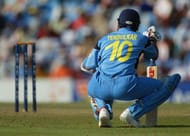
It was a match that Sachin Tendulkar was supposedly reminded of a year in advance. It was the first time the two sides were facing each other after a relatively long absence of bilateral ties.
With some heavyweights on either side, the contest was not only one for the ages, but it also threw up multiple sub-plots within the larger picture. Wasim Akram vs Sourav Ganguly, Shoaib Akhtar vs Sachin Tendulkar and Waqar Younis vs Rahul Dravid - could things get any better than that?
Pakistan chose to bat after winning the toss and were led from the front by Saeed Anwar, who had developed a penchant for making enormous runs against his neighbours.
Anwar batted till the 41st over, tackling an Indian bowling attack comprising of Javagal Srinath, Zaheer Khan, Ashish Nehra and Anil Kumble. Anwar’s presence ensured that one batting end was always tied up, thereby providing new batsmen ample time to settle in.
After Nehra managed to dismiss the opener for 101, the threat for India came in the form of a late innings surge from Rashid Latif, who along with Younis Khan helped Pakistan post a target of 274 runs.
Coming out to bat, the Indian openers famously got off to a flying start, reaching the 50 mark sometime in the sixth over. The opening assault was led by Sachin Tendulkar and Virender Sehwag, both batsmen in their prime at that point of time.
Tendulkar in particular was merciless towards the Pakistani bowling, and literally toyed with Akhtar’s line and length. Short-pitched deliveries were either being hooked or cut over third man, and full deliveries were being flicked or driven – all shots being played with equal ease.
After dismissing Sehwag and Ganguly off successive deliveries, Pakistan briefly had an opportunity to restore control over the game. But a 102-run partnership between Tendulkar and Mohammed Kaif ensured that that wouldn't happen.
Tendulkar fell for 98, excruciatingly close to yet another century, and Kaif got bowled for 35 off the bowling of Shahid Afridi.
The finishing act was left to Yuvraj Singh and Rahul Dravid, who closed the game for India with a 99-run partnership. They took India home with six wickets to spare and with more than four overs left in the game.
#1 Final, World T20 2007 at Johannesburg
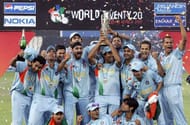
One of the most iconic matches in the history of the rivalry, this encounter played out in the aftermath of a tied game between the two teams during the league stage of the same tournament. While India narrowly managed to secure the two points through a bowl-out, the final was always supposed to be Pakistan’s grudge match, a game to settle scores.
What made the encounter poetic was the fact that barely six months previously, both the subcontinental giants had bowed out of the 50-over World Cup in the first round itself – losing to less fancied sides like Bangladesh and Ireland.
Much as this game was a redemption song for both teams, it was also the final of a World Cup. There was a winner-takes-all narrative surrounding it, thereby creating pressure of enormous magnitude.
India chose to bat first after winning the toss, and thanks to a gutsy innings from Gautam Gambhir (75) and a quickfire 30 from Rohit Sharma lower-down, managed to put 157 runs on the board - a score many thought was just about par.
The Pakistan innings started off with Mohammad Hafeez falling to RP Singh early, but the chase soon gathered steam with Imran Nazir blasting his way to a 14-ball 33, making India’s defence of 157 appear farcical.
Some brilliant fielding ensured that Nazir was run-out, thereby initiating a mini collapse for Pakistan. At 104/7 at the beginning of the 17th over, very few would have given Pakistan a chance. But Misbah-ul-Haq and Sohail Tanvir proved otherwise – taking Pakistan agonizingly close to the target.
Joginder Sharma, India’s hero of the day, bowled an exceptional last over to dismiss Misbah on 43, ensuring that India sealed the game with Pakistan still six runs short of the target.
The rest, as they say, is history.
Brand-new app in a brand-new avatar! Download CricRocket for fast cricket scores, rocket flicks, super notifications and much more! 🚀☄️
